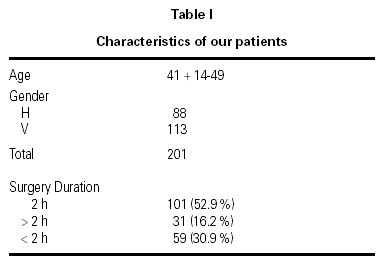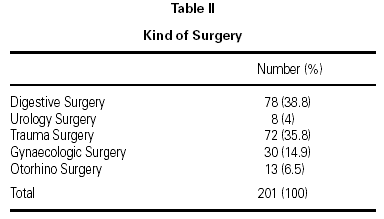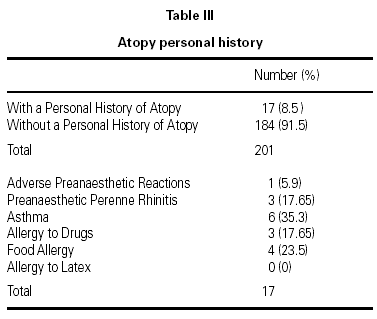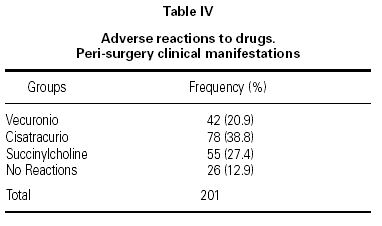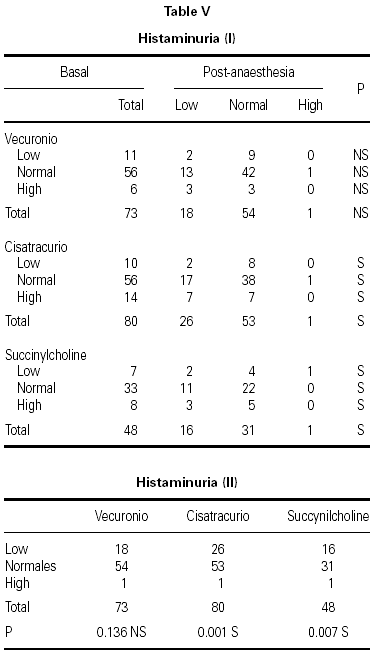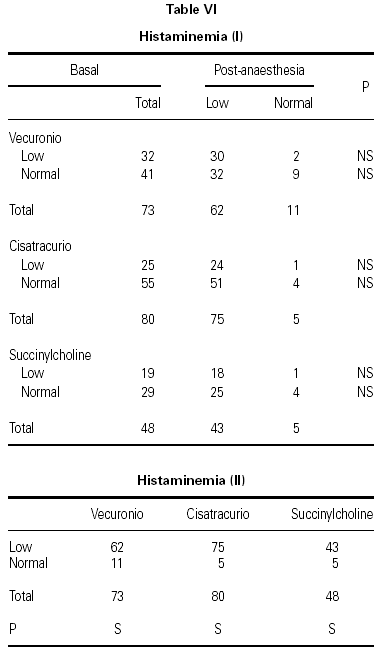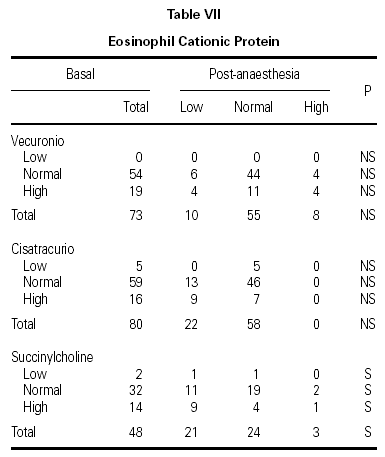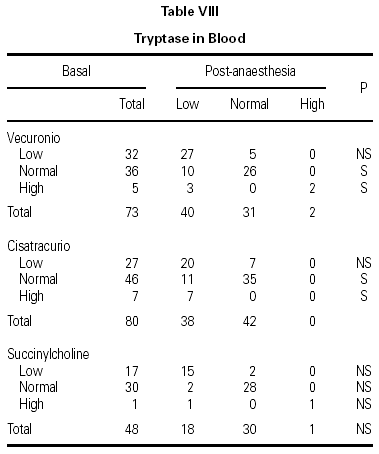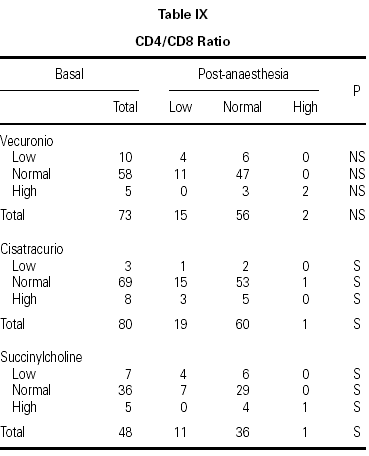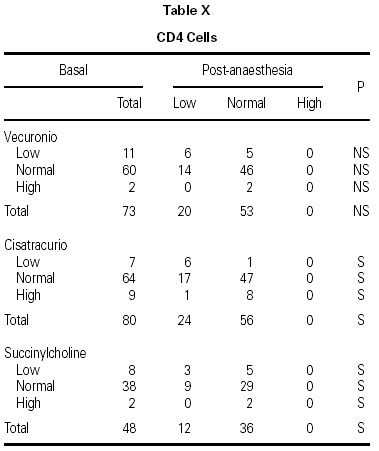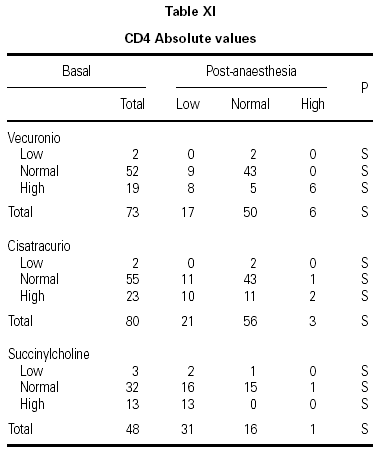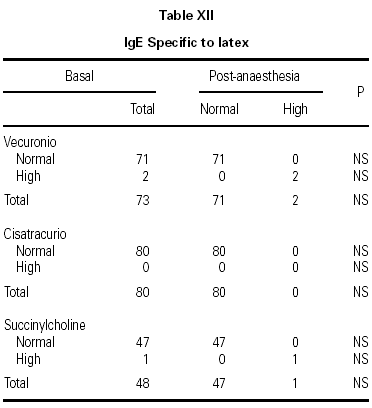INTRODUCTION
Allergic reactions, or supposed ones (anaphylactoid) aroused during anaesthesia, are a worldwide concern among anaesthesiologists, since they are sudden events able to provoke serious anoxic consequences, serious enough even to imply legal responsibilities. In the last ten years, several symposia focusing on this topic have been organized in France, England and Germany. Their main objective was the understanding of the undergoing mechanisms and the agents involved, and also the suggestion of preventive actions1,2. Early on, IgE-depending mechanisms were rarely evoked, and only was accepted the liberation of histamine due to hypnotics and certain coadjuvants3-5. After 1970, general conscience is gained about the importance of studies about allergologic tests and myorelaxants. This was mainly due to the collaboration studies among anaesthetists, biochemists and allergologists, allowing the implementation of IgE-dependent anaphylactic tests (skin tests, specific-IgE and muscle relaxant dosage, tryptase, etc.). Since the incidence of these reactions is quite low, its study requires gathering of a high number of patients was needed to implement and validate these tests. This is the reason why some institutions have been appointed as a reference in different countries such as France, England, Australia, New Zealand, Norway and Denmark, to unify the patients and perform the allergologic studies6,7.
It is considered today that around half the cases of per-surgical anaphylactoid reactions have an immunologic cause8. The incidence of these reaction could be established between 1/10,000 and 1/20,000 cases in Australia, and about 1/13,000 in France9.
Among the 4,400 anaphylactic cases of demonstrated per-anaesthetic origin, demonstrated after allergologic studies and published in international literature10, since 1981 curare-like drugs are the cause of 62 %, followed by 16.5 % of latex, 7.4 % of hypnotics, 4.7 % of antibiotics and 3.6 % of plasma substitutes (among them, 93 % due to gelatines). Opioids are rarely involved, with 1.9 %.
The releasing effect of histamine over the drugs used in general anaesthesia has been widely studied since 1939, when Allan accidentally reported that administration of curare (a complex mix of alkaloids, among which D-tubocuranine, a skeletal muscle relaxant, is remarked) provoked an increase in histamine11. Though medical literature reports that all anaesthetic drugs have a histamine release effect, this is not totally correct due to several reasons. First because the alleged releasing effect of some of these drugs has not yet been confirmed. Also, because factors different from those drugs administered, have often been disregarded. Some of them are able to provoke histamine liberation to bloodstream during anaesthesia; as an example, we know that just the stress associated to the patient's presence in the surgery room generates high basal levels of histaminemia. Also, endotracheal intubation, and even administration of saline physiological serum, may provoke considerable histamine release in some patients.
Laxenaire12 insists in the importance of a national network of allergo-anaesthetic consulting facilities, where performance of tests should follow physician's recommendations. This author also insists on a close collaboration between allergy and anaesthesia specialists in these facilities. This would allow the achievement of coherent conclusions and ulterior anaesthesia guidelines able to improve patient's safety. It is recommended that, in diagnosis of anaphylaxis, testing of serum tryptase and histamine is done after 1 hour, and also 8 weeks, of skin tests generation.
The Spanish societies for Allergology and Anaesthesiology established an action protocol, published by the Dirección General del Insalud, about allergogenic tests and anaesthesia, and also the consent document for both general and local anaesthesia of June 30th 1994. Demand concerning allergologic and anaesthesia tests has increased as consequence of a defensive medicine concerned by legal accusations against general anaesthesiologists, due to death of some patients under anaesthesia. Besides all this, medical literature about adverse reaction during surgery is not only inconclusive but sometimes also contradictory. This is particularly true concerning the immune mechanisms involved, risk factors, pre-medication, diagnosis methods and prevention.
This article's aim is to study modifications in the immune mediators due to three kinds of myorelaxants. It has a predictive intention and also the characterization of its incidence in our environment.
MATERIALS AND METHODS
This study has a prospective, transversal and observational design.
A population of 201 patients is included, provided by the Surgery Service of the Hospital General de Lanzarote, from October 1998 until January 2000.
Three groups of patients were included, 73 anaesthetized with Vecuronio, 80 by Cisatracurio and 48 by Succinylcholine. From all of them, a blood sample was obtained before and after surgery, to measure the following parameters: histaminemia, eosinophil cationic protein, tryptase, IgE against latex, total IgE, CD4 fraction, CD8, total lymphocyte, C3 and C4, and also histamine in urine.
Patients were among 17 and 70 years of age, with a surgery time up to 2 hours. We discarded patients that were atopic, pluri-medicated, with surgery longer than 2 hours, with some multi-pathology and also all those using bronchial dilating drugs, beta blocking drugs and anti-inflammatory drugs.
The next in vitro study methods were achieved:
Histamine in blood
The Inmunotech (Luminy, France) protocol was followed, using I125 antibody (Inmunotech) against histamine. 600 mL of plasma were used. Plasma was always stored at 20 °C. Reference value for healthy induviduals was 90 nMol/l. Gastric section increased to 9-18 nMol/L, tachycardia: 27-45 nMol/L, broncoespasm: 63-108 nMol/L. pH was 4-5.
Histamine in urine
Anticoagulant used was HCl, samples were preserved at 20 °C. Method used was from Inmunotech (Luminy, France) (EIA). Reference values were: 45-270 nMol/T, and 75-450 nMol/24 hours.
Excreted ureine methylhistamine. It was used as standard marker in cases of bronco spasm. Current and standard tests were used to study presence of elements causing anaphylactic reactions, such as skin tests, histamine release tests and RAST.
Tryptase in serum
A sample of 500 ml was used. Samples were refrigerated until use, fluoroimmunoanalysis method were used (CAP System). Reference values were of 5,5-13,5.
Tryptase in mast cells
This was used to characterize degranulation. Sera were obtained in the next 1-4 hours after reaction started. Sera were centrifuged and frozen until use. When tryptase is positive, less than 20 ng/mL indicates an IgE-mediated reaction (for example, anaphylaxis). Only a small percentage of patients presenting reactions associated with basophils, instead of mast cells, may have normal levels of tryptase in mast cells when suffering anaphylaxis.
Eosinophil Cationic Proteins
Samples were of 500 mL. Samples were refrigerated until use. Fluoroimmunoanalysis method was used (CAP System). Reference values were of 2.0-18.0.
CD4/CD8 cells
Haemathologic counter: Peutro RO. Flux cytometer: XL2 MCH CONTER. Monoclonal antibody used was C y TO-Sarat-Couller-Clone, using DR1 in T4 and FIK in T8.
CH100: Total Haemolytic Complement
Supplied by The Binding-Sitar. Spectrometry was performed with SHIM OD2 U-W-160. Sera samples were of 200 ml, stored at 20 °C. Reference values were of 45-270 nMol/T, valued were of 75-450 nMol/ 24 hours.
Total and specific IgE
Standard procedures and techniques were used, such as CAP System or RIA.
Latex allergen
K82 (Pharmacia) was used and determination was achieved by CAP System (Pharmacia).
RESULTS
Summarized in tables I to XII:
Table I: patients' characteristics. Average age was 41 years, higher in females than in males, and the majority having 2-hour surgery.
Table II: the kind of surgery performed, showing digestive surgery as the most represented, with 38.8 %.
Table III: family history and atopic history. The majority of our patients did not have an atopy personal history (184). It describes patients with asthma (6; 35.3 %), food allergy (4; 23.5 %); perennial rhinitis (3; 17.65 %) and drug allergy (2; 17.65 %).
Table IV: adverse reactions including peri-surgical clinical manifestations, being a higher for Cisatracurio (38.8 %), followed by Succinylcholine (27.4&) and Vecuronio (20.9 %).
Table V: histaminuria in different patients. It is appreciated that histamine is not clearly modified by Vecuronio; on the other hand, it is modified by Cisatracurio and Succinylcholine. Histaminemia, as shown in table VI, is not modified in none of the three groups.
Table VII: eosinophil cationic protein is modified only in the Succinylcholine group, but with no increase of its level.
Table VIII: levels of tryptase in blood are clearly modified by Vecuronio and Cisatracurio. Succinylcholine has not the same effect, since values tend to be smaller.
Table IX: Cisatracurio and Succinylcholine, being lower, significatively modify the CD4/CD8 ratio.
Table X: number of CD4 cells is clearly smaller by Cisatracurio and Succinylcholine. Similar result were observed for CD8 cells in the Succinylcholine group.
Table XI: absolute values for CD4 cells; it is appreciated a clear decrement by Vecuronio, Cisatracurio and Succinlylcholine. Same results are obtained for CD8 (data not shown).
Table XII: represents IgE specific to latex.
DISCUSSION
Our article studies modifications of mediators in patients that did not have any anaphylactic reaction during surgery. Most of the literature recommends, as diagnostic means of anaphylaxis, testing of serum tryptase and plasma histamine, methyl-histamine in urine and specific IgE. Also skin tests are recommended 6 to 8 weeks after suffering an alleged anaphylactic reaction12-15. See tables I, II and III for description.
We found adverse reactions of Grade 1, corresponding to a histamine release of 1 g/ml, mainly based in the apparition of erythema, urticaria or itching, with the following percentages:
1. Cisatracurio, 38.8 %. Is followed by the highest level of skin reaction in intradermal tests performed in our Unit, at the Hospital Universitario Insular de Gran Canaria. They were followed by 27.4 % for Succinylcholine and 20.9 % for Vecuronio. These patients did not have a family history of atopy, which coincides with other published works. They do not show a relationship between atopy and adverse reactions to myorelaxants16, from a predictive point of view. We did found neither anaphylactic reaction in any of our patients, nor sensitisation to latex, compared to other works describing approximately 50 % present IgE-depending reactions17. Also, latex was 16.5 % of anaphylactic reactions among 4,400 cases described in reference institutions; this being demonstrated by allergologic studies and reported in international literature15. This discrepancy in the results is due to the fact that those studies study all patients in a reference institution, and also because surgical material free of latex is on use, lately.
2. Risk factors are a controversial topic and we do not have predictive clinical parameters. Female patients are 4 to 1 more affected than male ones, reaching some series a prevalence of 74 % in Tiopental muscle relaxants and latex18. Though this last case is not surprising, since in all prevalence studies was performed with hospital staff of female majority19. It has also been published that atopy, allergy or asthma, may be a predisposing factor in some series (3 to 5 times higher), though some authors did not reach these conclusions20 since different definitions of atopy are used.
A history of asthma or allergy as predictors of anaphylactic reactions has very low sensitivity and specificity and implies unacceptable chances of false alarm. This relationship seems to be more real in sensitisation to latex21. In asthmatic patients, the only factor proved to worsen this pathology under anaesthesia is the positioning of the endotracheal tube22. In age studies, incidence differs with the age segment of the population under study. It is less frequent in youngsters with muscle relaxants, but is more frequent at this age with latex. According to the last published series23, previous exposition to muscle relaxants does not seem to be a predisposition factor. Although it could be in the case of latex and health care staff, children suffering from spina bifida and latex industry personnel24,25.
Repetition of general anaesthesia in a short period of time seems to be a significant risk factor, though authors report different percentages ranging from 20 to 75 % of patients showing reaction to muscle relaxants, not having received these drugs previously26. Small incidence increase of anaphylactoid reactions is not significant in patients with previous anaesthesia27.
In relation to the histamine releasing effect of muscle relaxants, a dose-dependent liberation has been demonstrated, being Atracurio the strongest one, followed by Succinylcholine, Pancuronio and Vecuronio, according to several authors.
We report here that Cisatracurio has the highest histamine-releasing potency in our patients, followed by Succinylcholine28.
Concerning mediators, histaminuria levels are significantly modified in Cisatracurio's group, with an overall decrease. We could not compare these data with others in the literature since no publications were found studying similar patients (see table VI) is not clearly modified in any group, differing this from other works in the literature. This also occurs with the eosinophil cationic protein and with tryptase. On the other hand a decrease of total lymphocyte number would indicate immunosupression. We did not find any patient sensitized, or with high IgE levels, to latex (see table XII). This could be due to the preventive actions followed by hospitals trying to use latex-free material.
In this work, adverse reactions were very low, and immune reaction mediators remained practically unmodified under a pathologic situation, but as a trend to immunosupression. Prevention of this sort of reactions must be done by unification of action criteria. Anaphylaxis diagnosismust be based on positive results of skin tests, biology and coherence of results with chemistry and anaesthesia protocol29.
The Revista Española de Anestesiología y Reanimación publishes an interesting multicentric prospective study performed by 20 hospitals in Catalonia between 1996 and 1997, coordinated by Escolano30. They studied those patients with anaphylactoid reaction, measuring tryptase and methylhistaminuria levels in blood. Later on, skin tests were performed in the same patients. In two years, they found 32 patients with anaphylactoid reactions having variable seriousness. In only 25 patients, they could study variations in immune mediators, and skin tests in only 8 of them.
CONCLUSIONS
1. Adverse reaction were low, when they appeared. From the 201 patients, only 17 had a previous history of atopy. Digestive surgery represents the majority of patients (38.8 %), with an average surgery time of two hours.
2. No adverse reaction to latex was found. Levels of specific IgE against latex were 0.
3. Histaminuria levels were clearly modified in those patients treated with Cisatracurio and Succinylcholine, being lower in both groups.
4. Histaminemia is not significantly modified in any of the three groups.
5. Eosinophil cationic protein is clearly modified in the Succinylcholine group, being higher in two cases with previous normal values.
6. We did not find high previous levels of tryptase in blood, being this modified after treatment in the three groups. With Cisatracurio, normal cases descended from 46 to 11, and with Vecuronio normal cases changed from 36 to 10.
7. CD4/CD8 ratio was significantly modified with Cisatracurio and Succinylcholine. It decreased in 15 cases from 69 patients with normal values; on the other hand, from 8 patients with high level, in three of them decreased. In the Succinylcholine group, from 7 patients with low levels, 3 became normal; from 36 normal, 7 decreased, and from 5 with high levels, 4 were normalized.
8. Levels of CD4 cells were modified with Cisatracurio and Succinylcholine. In the first case, from 64 patients with normal levels, in 17 was decreased. After Succinylcholine, from 38 patients, 9 had lower levels.
9. Levels of CD8 cells were modified with Cisatracurio and Succinylcholine, being lower in 7 from 68n normal patients, and in 3 from high-level subjects. Something similar occurs with Succinylcholine; 5 decrease out of 38 normal ones, and in 6 cases with high levels, 3 decrease.
10. Total levels of lymphocytes are modified, with a trend to lymphopenia.
11. Total IgE is significantly modified with Cisatracurio and Succinylcholine, decreasing from 23 to 11 normal determinations in the first case, and in the second case from 13 to 11.
12. Fractions of C3 complement are not clearly modified in none of the 3 groups. On the other hand, C4 is modified in the Vecuronio group, where 12 out of 52 are now lower.
13. In general, level modifications of immune mediators in our study are not clearly significant, with the exception of a pathological alteration (this is, level increase in normality). Surprisingly, in many cases of histaminemia or histaminuria, levels are lower.




